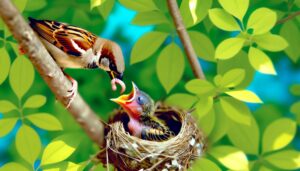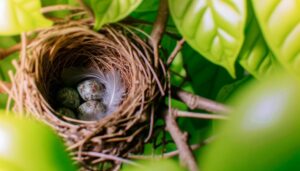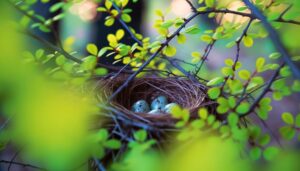7 Steps to Feed a Blind Fledgling Sparrow
Feeding a blind fledgling sparrow necessitates precise care and attention. First, gently conduct a thorough physical examination, noting any injuries or abnormalities.
Prepare a clean, quiet feeding area with non-abrasive materials. Opt for a high-quality hand-rearing formula, supplemented with insects and finely chopped hard-boiled eggs.
Avoid milk and bread. Formulate a nutrient-dense slurry and use a small, soft feeding syringe or dropper to administer it.
Feed at regular intervals and closely monitor the crop to avoid overfeeding. Regularly assess the bird's weight, feather condition, and behavior, and consult an avian veterinarian.
To understand more detailed procedures, follow along for expert advice.
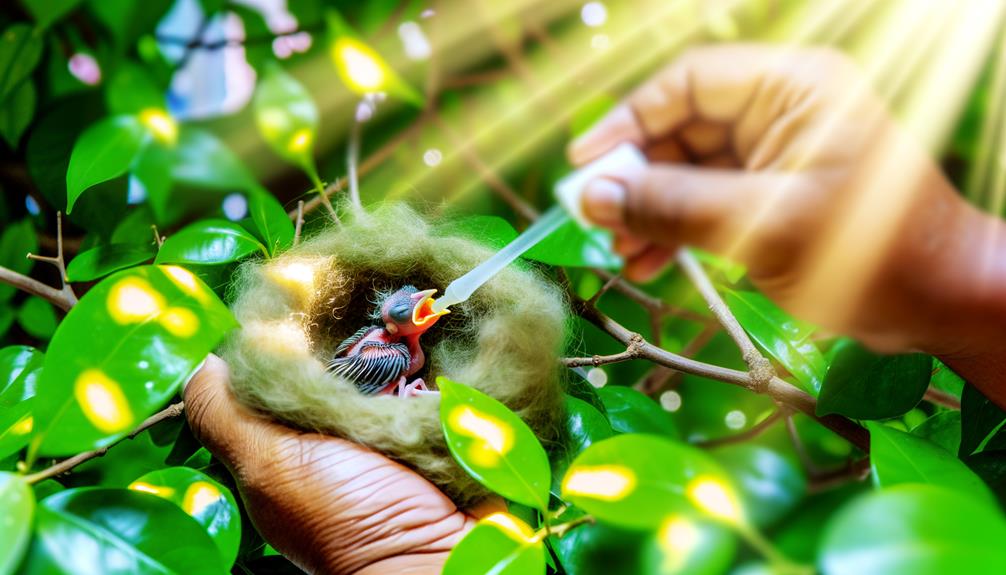
Key Takeaways
- Use a small, soft feeding syringe or dropper to feed the sparrow.
- Ensure the feeding area is quiet, secure, and free from direct sunlight.
- Formulate a nutrient-dense slurry using high-quality hand-rearing formula.
- Gently open the sparrow's beak and feed at regular intervals, monitoring the crop to avoid overfeeding.
- Regularly assess the sparrow's weight, feather condition, and behavior, and consult an avian veterinarian as needed.
Assess the Sparrow's Condition
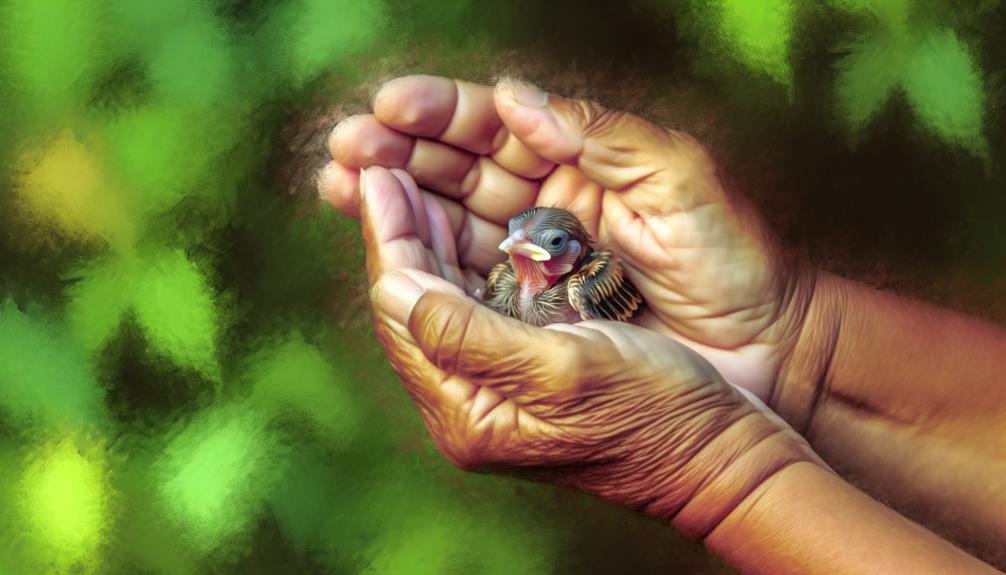
The first step in evaluating a blind fledgling sparrow's condition is to conduct a thorough physical examination to identify any signs of injury, illness, or distress. Start by gently handling the sparrow to assess its overall physical state.
Examine the wings for fractures or dislocation by carefully extending them. Inspect the body for any swelling, abrasions, or feather loss. Pay close attention to the eyes, noting any discharge or abnormalities indicating potential infections or congenital issues. Check the beak and oral cavity for lesions or deformities.
Assess the bird's weight and hydration status by feeling the keel bone and observing skin elasticity. Document all findings meticulously to inform further care and intervention strategies, ensuring the sparrow's best possible recovery.
Preparing the Feeding Area
Creating an ideal feeding environment involves securing a clean, quiet, and secure space to minimize stress and prevent contamination. Begin by selecting a stable, flat surface, preferably covered with a disposable, non-toxic liner. This aids in maintaining hygiene and provides a tactile reference point for the fledgling.
Make sure the area is free from drafts and direct sunlight, which can cause temperature fluctuations harmful to the bird's health. Utilize soft, non-abrasive materials to create a gentle, non-threatening atmosphere. Sterilize any feeding implements using a mild, bird-safe disinfectant before each use.
Reduce ambient noise to prevent startling the fledgling, and secure the space is inaccessible to pets or children. These measures will create an optimal setting for feeding a blind fledgling sparrow.
Choosing the Right Food
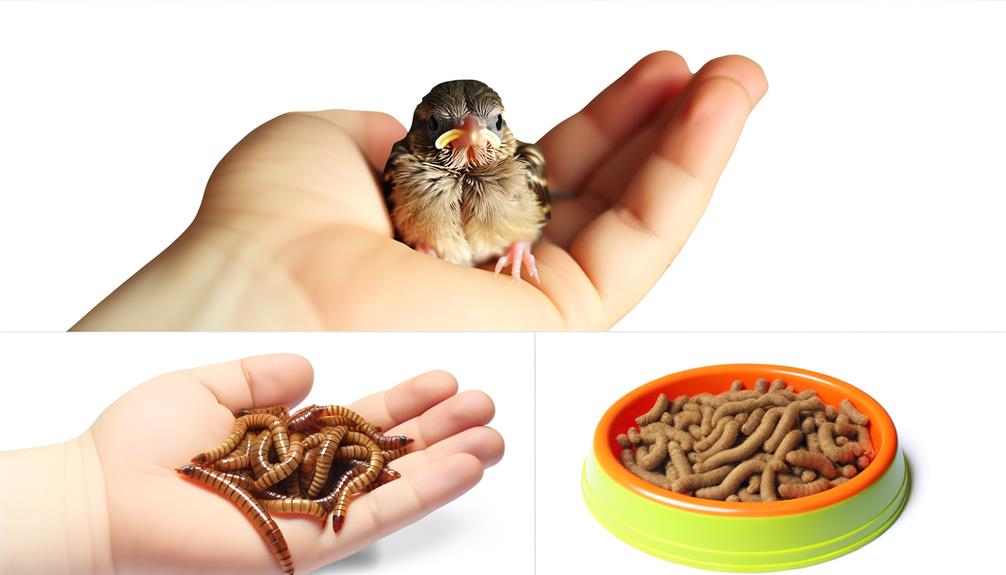
Once the feeding environment is properly prepared, selecting an appropriate diet for a blind fledgling sparrow is crucial for its growth and recovery. Initially, consider using a high-quality commercial hand-rearing formula specifically designed for passerines, as it provides balanced nutrition.
Supplement this with small, easily digestible insects such as mealworms, which are rich in protein. Make sure the insects are appropriately sized to avoid choking hazards. Additionally, finely chopped hard-boiled eggs can be included to enhance protein intake.
Avoid feeding milk or bread, as these can cause digestive issues. Fresh water should be available at all times, but in shallow containers to prevent drowning. Regularly consult avian veterinary guidelines to adapt the diet as the fledgling matures.
Feeding Techniques
Administering nourishment to a blind fledgling sparrow requires meticulous technique to guarantee proper ingestion and avoid aspiration.
Begin by formulating a nutrient-dense slurry using high-quality bird formula, ensuring a smooth consistency.
Utilize a small, soft feeding syringe or dropper to administer the slurry.
Gently open the sparrow's beak with a fingernail or specialized tool, placing the dropper tip at the side of the beak to control flow.
Deliver small amounts, allowing the bird to swallow between drops to prevent choking.
Maintain a 45-degree angle to support natural swallowing reflexes.
Feed at regular intervals, typically every 15-20 minutes during daylight hours.
Monitor the bird's crop to avoid overfeeding, ensuring it empties between meals.
Monitoring Health and Growth
To promote the best development of a blind fledgling sparrow, it is essential to carefully monitor its health and growth metrics. Regularly assess weight, feather condition, and general behavior. Document these metrics to track progress effectively. Utilize the table below for a structured monitoring approach:
| Metric | Ideal Range/Notes |
|---|---|
| Weight | Consistent daily gain (grams) |
| Feather Condition | Smooth, intact, no bald spots |
| Feeding Response | Active, responsive to feeding cues |
| Vocalizations | Regular, strong chirping |
| Activity Levels | Consistent movement, alertness |
Maintaining detailed records helps identify deviations early, allowing prompt intervention. Regular consultations with an avian veterinarian are recommended to ensure the fledgling's best health and development.
Conclusion
To wrap it up, ensuring the well-being of a blind fledgling sparrow requires careful attention to its condition, a thoughtfully arranged feeding area, suitable food selection, and precise feeding techniques.
Continuous monitoring of health and growth is crucial to adjust care as necessary.
As the saying goes, 'Prevention is better than cure,' highlighting the significance of proactive measures in avian care to promote excellent development and survival of the fledgling.


